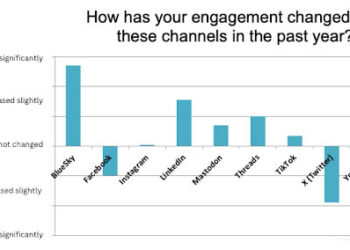
- Image via Wikipedia
Advertisers (and I use the term advisedly to mean people who create awareness as part of persuading people to buy their products) have long been battling to have online advertising be precisely what the name promises — online advertising.
A pernicious mindset entered into online promotion early, namely the calculation that because you could measure impressions and clicks, online advertising was more like direct marketing, and should be treated as such. Not measuring it was foolish.
But not everything that can be measured matters, and not everything that matters can be measured.
The measurement mindset persists to this day. People who possess it were once was obsessed with click-throughs, but now they are obsessed with “targeting.” With all the rich user information we can get, the direct marketing cum advertising mindset says, if I can target demographics, psychographics, user habits, and, heck, why not something like handedness (right or left), I won’t waste money advertising my left-handed scissors to right-handed people who don’t regularly use scissors. I’ll target lefties who sew or quilt. I will be a more efficient advertiser.
There are three problems with this logic:
- It doesn’t factor in the fatigue (with ads and with the topic in general) targeted users will, or may already, experience around products designed specifically for areas they’re already deeply invested in
- It doesn’t factor in the value diminution targeting ultimately will experience for advertisers and the sites they use
- It continues to fail to recognize the power of advertising
Let’s take the example of a left-handed quilter. If a company specializing in left-handed scissors uses targeting to its logical extreme, the lefty quilter will often see ads for lefty scissors in email alerts from favorite sewing sites, on the sites themselves, and on other sites and in other emails from news sites that do fine-grained targeting.
Of course, at some point, the ads will get tuned out. The creative will become too familiar, repetitive, and uninteresting. It will be white-noise. Click-through rates fall yet again, perhaps even below those for standard, non-targeted campaigns. Repetitive targeting ends up having the paradoxical effect of desensitizing the target audience.
Also, chances are that the left-handed quilter already has dealt with the lefty scissors issue. This is why targeting has a short shelf-life.
In a recent study from the MIT Sloan School of Management, the profitability of advertising to smaller and smaller slices was analyzed, with the author concluding that not only does profitability fall when the slices get too small, but as everyone targets, pricing competition heats up. However, because there will be so much targeting possible, the prices will be driven down, not up. Prices can’t go up because targeting isn’t profitable enough to support upward price competition.
Targeting provides an advantage as long as only a few players are targeting. This “early adopter” advantage is part of the land rush to targeting, yet so many people moving quickly into a space like this will only dilute the value of targeting. If everyone is targeting, and the slices are becoming smaller and smaller, you are headed to 1:1 persuasion, which is essentially personal selling. And that’s no longer advertising — it’s sales.
An interesting aside in the MIT study is the speculation that the only way targeting holds value is if its conducted by monopolies. This can mean ad networks, but it also can mean sellers. On the ad network front, a monopoly could drive prices up while leaving profitability to fall — so, an ineffective monopoly. On the seller side, these monopolies don’t need to advertise much to win, so targeting becomes mainly about efficiency. And if the supply of targeting outstrips the demand for targeting, targeting itself becomes less valuable.
This is how value diminution derails ad targeting.
Let’s return to the example of the left-handed quilter, and talk about the value of advertising and how it generates profits. Instead of targeted ads to left-handed quilters, let’s say I take out a general run-of-site ad on the New York Times, and have no expectation of click-throughs. I’m going to measure business results, not technical results — profitability instead of clicks. And instead of a metric-driven mindset, I’m going to persuade through reach (broad exposure to my ads) and frequency (repetitive exposures to my ads)
In other words, I advertise.
Who might I attract? Well, the quilter’s brother might think scissors would be a nice gift. Another left-handed person, who doesn’t quilt, might have never seen left-handed scissors before, and want a pair. The mother of a left-handed child might think getting a pair for the house would make sense now that the child is old enough.
This is the power of advertising. You reach customers, create awareness, and generate interest, often reaching people and populations you didn’t know how to reach otherwise. It’s wasteful, expensive, but ultimately may be more profitable than targeted online advertising that doesn’t break the reach and frequency thresholds to make a difference. Advertising is different because it reaches new customers, creates awareness, and generates interest in a larger population.
To some degree, this is a semantics issue. If current “online advertisers” redefined themselves as “online marketers,” with their banner purchases actually more akin to direct mail pieces distributed via web sites, the discussion might be more productive and reasonable. What is the value of the list? How many pieces do you get to distribute? What’s your ROI on each DM campaign?
Meanwhile, “advertising” could be sold for what it is, and at a price point that is more in line with its unique power.
Finally, super-targeted (i.e., 1:1) online sales approaches could be defined and sold as such.
Until we get our concepts right, the direct marketing specter will continue to haunt online advertising with a conflated pipe-dream of direct sales being realized through something mislabeled as “advertising.”
And for any sales, promotion, or advertising approach that attempts targeting, I think the lesson will be one of moderation — some targeting, but not too much; careful targeting, but not too specific or restrictive or repetitive; personal targeting, but not too personal.
It’s a boring lesson. Oddly, it’s a lesson that doesn’t advertise itself — but it certainly targets people who ignore it.
Discussion
11 Thoughts on "Will Ad Targeting Lead to a Lesson in Moderation?"
This analysis is spot on. Unfortunately, I don’t think advertising agencies – particularly their media buying divisions – are open to persuasion.
Amazon’s been driving me crazy lately with their “targeted” marketing based on the gifts I bought for others this holiday season. Though I don’t own a Blu-Ray player, I sent a disc to a relative, and now Amazon seems to think I want daily e-mails about specials on Blu-Ray discs. Isn’t Amazon supposed to be a real leader in this market? You’d think they could differentiate between items sent to others and to oneself.
Amazon’s analytics and matching algorithms are overrated, I think. They need to redevelop them. For instance, their rankings on books don’t consolidate e-books with print books, and for print books, they don’t consolidate books sold directly by Amazon with those sold through Amazon sellers. And the gifting problem has been around since Day 1 for them. You would think they’d spend some time and $$ to straighten these things out.
Actually, Amazon does offer a solution to the gift issue, but it’s cumbersome for the user. You can affect the recommendations you receive by deleting items they use in the algorithm. David can tell Amazon to ignore the disc in its calculations. You have to do this one by one, though, and most people probably don’t bother.
There’s a lot of truth here, although I think it has less to do with targeting than to do with advertising in general. For example, creatives becoming too familiar and uninteresting is not a failure of targeting–it’s a failure of advertisers to be creative.
Certainly there are cases in which blanketing a delivery channel with a message, regardless of whether or not it’s relevant to the majority of customers of that channel, is better than targeting, but I think these situations are few and far between.
Effective targeting is able to respond to changes in customer needs and product offerings. This happens in the information industry (new content is published regularly), but not so much in your example, where handedness is not likely to change.
So while I agree with you that targeting is not without its flaws (like any strategy or tactic, in the wrong hands it is either useless or detrimental to the bottom line), in moderation it’s very powerful. For evidence of this, just look to Google.
Kevin Cohn
Director of Product Management
Atypon
Kevin, I agree — in moderation, targeting can be effective. My guess is that the tenacity with which some people are pursuing targeting will abate soon, as reality sets in. I also think there’s a temptation to call online DM “advertising” when its goals and tactics are much more akin to direct marketing.
I often think billboard advertising can be pretty effective, but targeting I-90 can’t be that subtle!
Well reasoned post!
If I were to put words in your mouth, I’d say you’re not arguing against targeting as much as warning against picking the wrong the packaging and pricing.
There are more choices than ever before. This is not only because of the ability to “slice smaller,” as you point out, but because of new forms of media and pricing brought about by a maturing online ad market. Now marketers can choose any combination of:
1) Audience: Broad or narrow
2) Pricing model: CPM, CPC, CPA, others
3) Context: Brand-centric, content-centric, others
Just in that list of three there are… 24 permutations! And THEN you have to feel like you’re getting the right value for the money.
So again, I don’t think that targeting is the enemy, it’s choosing the right package across those variables.
Ryan Jones
President
http://www.pubget.com
One other benefit of mass advertisement over targeted selling is that many purchases are impulsive. The purchaser did not have a premotivated goal of buying the item, but somehow got convinced (or persuaded) that he had to have one.
Targeting ads based on previous purchasing history implies that history is a good predictor of future habits. Without any other knowledge of who David Crotty is and the purpose of his last transaction, trying to sell him another Blu-Ray disc is the best Amazon could do. Not very effective, but probably a better bet than trying to sell him a pair of fuzzy slippers or a naugahyde barcalounger.
Wonderful example, Kent! I’m lefthanded, but I have never bought anything designed for lefthanded people. Nonetheless, I have a large assortment of lefty-oriented objects (including scissors) given to me by friends and relatives. One of the frustrating aspects of online purchasing is the often resulting deluge of direct mail email that follows. It can be sufficiently annoying to produce a negative impression of the company and prevent future sales.
![Reblog this post [with Zemanta]](http://img.zemanta.com/reblog_e.png?x-id=51d1cfe9-91a8-4c83-81fa-289c576fb4ce)


